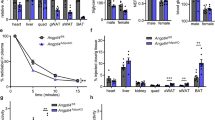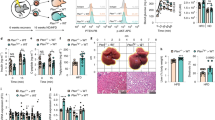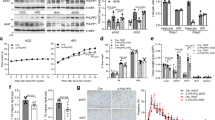Abstract
The adipocyte fatty-acid–binding protein, aP2, has an important role in regulating systemic insulin resistance and lipid metabolism. Here we demonstrate that aP2 is also expressed in macrophages, has a significant role in their biological responses and contributes to the development of atherosclerosis. Apolipoprotein E (ApoE)-deficient mice also deficient for aP2 showed protection from atherosclerosis in the absence of significant differences in serum lipids or insulin sensitivity. aP2-deficient macrophages showed alterations in inflammatory cytokine production and a reduced ability to accumulate cholesterol esters when exposed to modified lipoproteins. Apoe−/− mice with Ap2+/+ adipocytes and Ap2−/− macrophages generated by bone-marrow transplantation showed a comparable reduction in atherosclerotic lesions to those with total aP2 deficiency, indicating an independent role for macrophage aP2 in atherogenesis. Through its distinct actions in adipocytes and macrophages, aP2 provides a link between features of the metabolic syndrome and could be a new therapeutic target for the prevention of atherosclerosis.
This is a preview of subscription content, access via your institution
Access options
Subscribe to this journal
Receive 12 print issues and online access
$209.00 per year
only $17.42 per issue
Buy this article
- Purchase on Springer Link
- Instant access to full article PDF
Prices may be subject to local taxes which are calculated during checkout




Similar content being viewed by others
References
Glatz, J.F.C. & van der Vusse, G.J. Cellular fatty acid-binding proteins:their function and physiological significance. Prog. Lipid Res. 35, 243–282 (1996).
Coe, N.R. & Bernlohr, D.A. Physiological properties and functions of intracellular fatty acid-binding proteins. Biochim. Biophys. Acta 1391, 287–306 (1998).
Spiegelman, B.M., Frank, M. & Green, H. Molecular cloning of mRNA from 3T3 adipocytes. Regulation of mRNA content for glycerolphosphate dehydrogenase and other differentiation-dependent proteins during adipocyte development. J. Biol. Chem. 258, 10083–10089 (1983).
Hunt, C.R., Ro, J.H., Dobson, D.E., Min, H.Y. & Spiegelman, B.M. Adipocyte P2 gene: developmental expression and homology of 5′-flanking sequences among fat cell-specific genes. Proc. Natl. Acad. Sci. USA 83, 3786–3790 (1986).
Amri, E.-Z., Bertrand, B., Ailhaud, G. & Grimaldi, P. Regulation of adipose cell differentiation. I. Fatty acids are inducers of the aP2 gene expression. J. Lipid Res. 32, 1449–1456 (1991).
Distel, R.J., Robinson, G.S. & Spiegelman, B.M. Fatty acid regulation of gene expression. Transcriptional and post-transcriptional mechanisms. J. Biol. Chem. 267, 5937–5941 (1992).
Hotamisligil, G.S. et al. Uncoupling of obesity from insulin resistance through a targeted mutation in aP2, the adipocyte fatty acid binding protein. Science 274, 1377–1379 (1996).
Uysal, K.T., Scheja, L., Wiesbrock, S.M., Bonner-Weir, S. & Hotamisligil, G.S. Improved glucose and lipid metabolism in genetically obese mice lacking aP2. Endocrinology 141, 3388–3396 (2000).
Coe, N.R., Simpson, M.A. & Bernlohr, D.A. Targeted disruption of the adipocyte lipid-binding protein (aP2 protein) gene impairs fat cell lipolysis and increases cellular fatty acid levels. J. Lipid Res. 40, 967–972 (1999).
Scheja, L. et al. Altered insulin secretion associated with reduced lipolytic efficiency in aP2−/− mice. Diabetes 48, 1987–1994 (1999).
Cousin, B. et al. A role for preadipocytes as macrophage-like cells. FASEB J. 13, 305–312 (1999).
Ricote, M., Li, A.C., Willson, T.M., Kelly, C.J. & Glass, C.K. The peroxisome proliferator-activated receptor-gamma is a negative regulator of macrophage activation. Nature 391, 79–82 (1998).
Jiang, C., Ting, A.T. & Seed, B. PPAR-γ agonists inhibit production of monocyte inflammatory cytokines. Nature 391, 82–86 (1998).
Ricote, M. et al. Expression of the peroxisome proliferator-activated receptor γ (PPAR γ) in human atherosclerosis and regulation in macrophages by colony stimulating factors and oxidized low density lipoprotein. Proc. Natl. Acad. Sci. USA 95, 7614–7619 (1998).
Nagy, L., Tontonoz, P., Alvarez, J.G., Chen, H. & Evans, R.M. Oxidized LDL regulates macrophage gene expression through ligand activation of PPAR-γ. Cell 93, 229–240 (1998).
Tontonoz, P., Nagy, L., Alvarez, J.G.A., Thomazy, V.A. & Evans, R.M. PPAR-γ Promotes Monocyte/Macrophage Differentiation and Uptake Of Oxidized LDL. Cell 93, 241–252 (1998).
Pelton, P.D., Zhou, L., Demarest, K.T. & Burris, T.P. PPARγ activation induces the expression of the adipocyte fatty acid binding protein gene in human monocytes. Biochem. Biophys. Res. Comm. 261, 456–458 (1999).
Fu, Y., Luo, N. & Lopes-Virella, M.F. Oxidized LDL induces the expression of ALBP/aP2 mRNA and protein in human THP-1 macrophages. J. Lipid Res. 41, 2017–2023 (2000).
Surwit, R.S., Kuhn, C.M., Cochrane, C., McCubbin, J.A. & Feinglos, M.N. Diet-induced type II diabetes in C57BL/6J mice. Diabetes 37, 1163–1167 (1988).
Kunjathoor, V.V., Wilson, D.L. & LeBoeuf, R.C. Increased atherosclerosis in streptozotocin-induced diabetic mice. J. Clin.Invest. 97, 1767–1773 (1996).
Kraal, G., Rep, M. & Janse, M. Macrophages in T and B cell compartments and other tissue macrophages recognized by monoclonal antibody MOMA-2. Scand. J. Immunol. 26, 653–661 (1987).
Linton, M.F., Atkinson, J.B. & Fazio, S. Prevention of atherosclerosis in apoE deficient mice by bone marrow transplantation. Science 267, 1034–1037 (1995).
Fazio, S. et al. Increased atherosclerosis in C57BL/6 mice reconstituted with apolipoprotein E null macrophages. Proc. Natl. Acad. Sci. USA 94, 4647–4652 (1997).
Linton, M.F., Babaev, V.R., Gleaves, L.A. & Fazio, S. A direct role for the macrophage low density lipoprotein receptor in atherosclerotic lesion formation. J. Biol. Chem. 274, 19204–19210 (1999).
Babaev, V.R. et al. Macrophage lipoprotein lipase promotes foam cell formation and atherosclerosis in vivo. J. Clin. Invest. 103, 1697–1705 (1999).
Wolfrum, C., Borrmann, C.M., Borchers, T. & Spener, F. Fatty acids and hypolipidemic drugs regulate peroxisome proliferator-activated receptors α- and γ-mediated gene expression via liver fatty acid binding protein: A signaling path to the nucleus. Proc. Natl. Acad. Sci. USA 98, 2323–2328 (2001).
Davis, P.J. n-3 and n-6 polyunsaturated fatty acids have different effects on acyl-CoA:cholesterol acyltransferase in J774 macrophages. Biochem. Cell Biol. 70, 1313–1318 (1992).
Rumsey, S.C., Galeano, N.F., Lipschitz, B. & Deckelbaum, R.J. Oleate and other long chain fatty acids stimulate low density lipoprotein receptor activity by enhancing acyl coenzyme A:cholesterol acyltransferase activity and altering intracellular regulatory cholesterol pools in cultured cells. J. Biol. Chem. 270, 10008–10016 (1995).
Fazio, S. et al. Increased atherosclerosis in LDL receptor-null mice lacking ACAT1 in macrophages. J. Clin. Invest. 107, 163–171 (2001).
Babaev, V.R., Patel, M.B., Semenkovich, C.F., Fazio, S. & Linton, M.F. Macrophage lipoprotein lipase promotes foam cell formation and atherosclerosis in low density lipoprotein receptor-deficient mice. J. Biol. Chem. 275, 26293–26299 (2000).
Zhang, S.H., Reddick, R.L., Piedrahita, J.A. & Maeda, N. Spontaneous hypercholesterolemia and arterial lesions in mice lacking apolipoprotein E. Science 258, 468–471 (1992).
Linton, M.F., Hasty, A.H., Babaev, V.R. & Fazio, S. Hepatic ApoE expression is required for remnant lipoprotein clearance in the absence of the low density lipoprotein receptor. J. Clin. Invest. 101, 1726–1736 (1998).
Fazio, S. et al. Leukocyte low density lipoprotein receptor (LDL-R) does not contribute to LDL clearance in vivo: bone marrow transplantation studies in the mouse. J. Lipid Res. 38, 391–400 (1997).
Uysal, K.T., Wiesbrock, S.M., Marino, M.W. & Hotamisligil, G.S. Protection from obesity-induced insulin resistance in mice lacking TNF-α function. Nature 389, 610–614 (1997).
Uysal, K.T., Wiesbrock, S.M. & Hotamisligil, G.S. Functional analysis of TNF receptors in TNF-α-mediated insulin resistance in genetic obesity. Endocrinology 139, 4832–4838 (1998).
Tangirala, R.K., Rubin, E.M. & Palinski, W. Quantitation of atherosclerosis in murine models: correlation between lesions in the aortic origin and in the entire aorta, and differences in the extent of lesions between sexes in LDL receptor-deficient and apolipoprotein E-deficient mice. J. Lipid Res. 36, 2320–2328 (1995).
Paigen, B., Morrow, A., Holmes, P.A., Mitchell, D. & Williams, R.A. Quantitative assessment of atherosclerotic lesions in mice. Atherosclerosis 68, 231–240 (1987).
Kiener, P.A. et al. Stimulation of CD40 with purified soluble gp39 induces proinflammatory responses in human monocytes. J. Immunol. 155, 4917–4925 (1995).
Blasi, E. et al. Selective immortalization of murine macrophages from fresh bone marrow by a raf/myc recombinant murine retrovirus. Nature 318, 667–670 (1985).
Brown, W.J., Warfel, J. & Greenspan, P. Use of Nile red stain in the detection of cholesteryl ester accumulation in acid lipase-deficient fibroblasts. Arch. Pathol. Lab. Med. 112, 295–297 (1988).
Acknowledgements
This work was supported by National Institutes of Health grant HL65405-01. M.F.L., S.F., and J.S. are established investigators of the American Heart Association. J.B. is supported by a Diabetes Training Grant from the NIDDK (T32 DK7061). K.M. is supported by a postdoctoral fellowship from Manpei Suzuki Diabetes Foundation. G.S.H. is Pew Scholar in Biomedical Sciences.
Author information
Authors and Affiliations
Corresponding authors
Rights and permissions
About this article
Cite this article
Makowski, L., Boord, J., Maeda, K. et al. Lack of macrophage fatty-acid–binding protein aP2 protects mice deficient in apolipoprotein E against atherosclerosis. Nat Med 7, 699–705 (2001). https://doi.org/10.1038/89076
Received:
Accepted:
Issue Date:
DOI: https://doi.org/10.1038/89076
This article is cited by
-
FABP7 drives an inflammatory response in human astrocytes and is upregulated in Alzheimer’s disease
GeroScience (2023)
-
TMT-based quantitative proteomic profiling of human monocyte-derived macrophages and foam cells
Proteome Science (2022)
-
LDL delivery of microbial small RNAs drives atherosclerosis through macrophage TLR8
Nature Cell Biology (2022)
-
Pre-emptive pharmacological inhibition of fatty acid–binding protein 4 attenuates kidney fibrosis by reprogramming tubular lipid metabolism
Cell Death & Disease (2021)
-
Elevated circulating FABP4 concentration predicts cardiovascular death in a general population: a 12-year prospective study
Scientific Reports (2021)



